Are you a Quiet Speculation member?
If not, now is a perfect time to join up! Our powerful tools, breaking-news analysis, and exclusive Discord channel will make sure you stay up to date and ahead of the curve.
Days before the impact of companion on Modern was impressed upon me, I came across an article over at Good Grief Games by Kenan Diab on his RG Prowess deck. The idea was simple: take the persistently successful Mono-Red Prowess deck and cover for some of its glaring weaknesses by accommodating green creatures, in this case a couple of my own favorites in Tarmogoyf and Hooting Mandrills. Today, I'll give my impressions on the deck and discuss some adaptions it can make to accommodate companion.
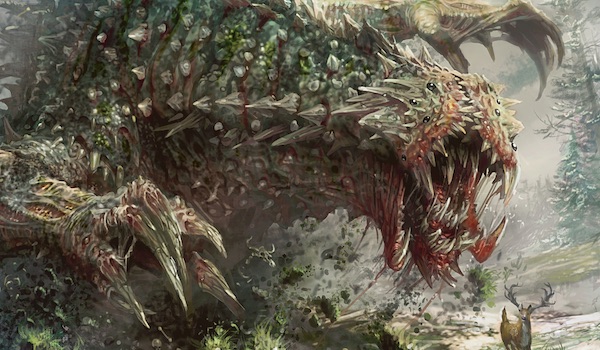
For starters, here's Kenan's list and a paragraph about the concept.
RG Prowess, Kenan Diab
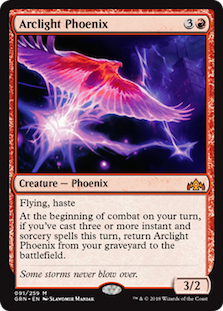 Goyf and Mandrills are adequately sized for Modern, and attack opponents from different angles than the rest of the deck. Both also provide effective backup plans should opponents swiftly answer the deck's one-drops, in the same way Arclight Phoenix did while Faithless Looting was legal, and that Bedlam Reveler attempts to in Mono-Red. Some differences between the green threats and Reveler: the former break the pseudo-mirror wide open, likewise prove trumps against Ponza, and more explicitly play to the deck's damage-doling Plan A in the face of removal, whereas Reveler forces pilots into a slower, more card-advantage-centric route.
Goyf and Mandrills are adequately sized for Modern, and attack opponents from different angles than the rest of the deck. Both also provide effective backup plans should opponents swiftly answer the deck's one-drops, in the same way Arclight Phoenix did while Faithless Looting was legal, and that Bedlam Reveler attempts to in Mono-Red. Some differences between the green threats and Reveler: the former break the pseudo-mirror wide open, likewise prove trumps against Ponza, and more explicitly play to the deck's damage-doling Plan A in the face of removal, whereas Reveler forces pilots into a slower, more card-advantage-centric route.
Right away, the deck set off my pleasure sensors. Here was Hooting Mandrills in a deck without black, not to mention a decisive commitment to fueling Tarmogoyf. And the deck is clearly aggressive with ample board interaction, another direction I favor. But there were a couple elements I didn't like: inflexible reach spells like Lava Spike, for instance, which I'd come to consider an unfortunate reality of running Monastery Swiftspear. So I read the article to see if I could somehow finagle my way out of running Spike.
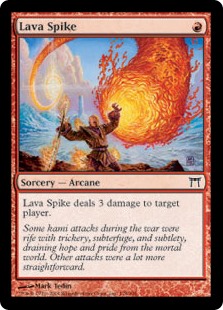 The Tweaks
The Tweaks
It turns out Spike was one of Kenan's least favorite cards in the list, or to use his words, "just filler." He also expressed disdain for bae Tarfire. I was more than happy to trim the Spikes right away, but actually gave one of those slots to another Tarfire---not out of spite, but out of purpose. I want to see Tarfire every game because I'm here to grow Tarmogoyfs!
Filling In the Blanks
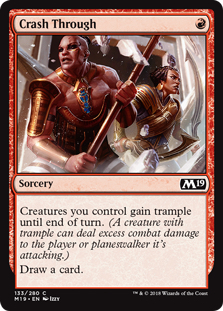 The other two spots went to Crash Through and Flame Jab. Crash has been excelling not just in Mono-Red Prowess, where it helps the deck's smaller creatures (and also Bedlam Reveler) penetrate fields of blockers, but in newer iterations of Death's Shadow Zoo (which I motion we all start calling Death's Shadow Prowess; the deck doesn't even play Wild Nacatl anymore!). Swiftspear, Goyf, and Shadow are all prime candidates for making use of the sorcery, and I figured the same held true here, even though Mandrills already features the keyword.
The other two spots went to Crash Through and Flame Jab. Crash has been excelling not just in Mono-Red Prowess, where it helps the deck's smaller creatures (and also Bedlam Reveler) penetrate fields of blockers, but in newer iterations of Death's Shadow Zoo (which I motion we all start calling Death's Shadow Prowess; the deck doesn't even play Wild Nacatl anymore!). Swiftspear, Goyf, and Shadow are all prime candidates for making use of the sorcery, and I figured the same held true here, even though Mandrills already features the keyword.
As for Flame Jab, I sometimes would find myself flooding out on lands, something Kenan acknowledged could come up without Reveler in the picture. Jab is a repeatable prowess trigger in those situations and can also gun down weaker creatures as does Lava Spike. Jab replaced what had started as a second Crash.
Laughing Out Lurrus
A couple nights of grinding revealed Modern's current obsession with Lurrus of the Dream-Den, and that's when the FOMO set in. These decks were splashing Mishra's Bauble and Seal of Fire just to extract additional value from the companion, and here I was playing those cards anyway. Perhaps the Nightmare Cat's strongest suitor was Jund, a deck that could regain heaps of value by casting Lurrus and recouping Tarmogoyf. Hey, I ran that card, too!
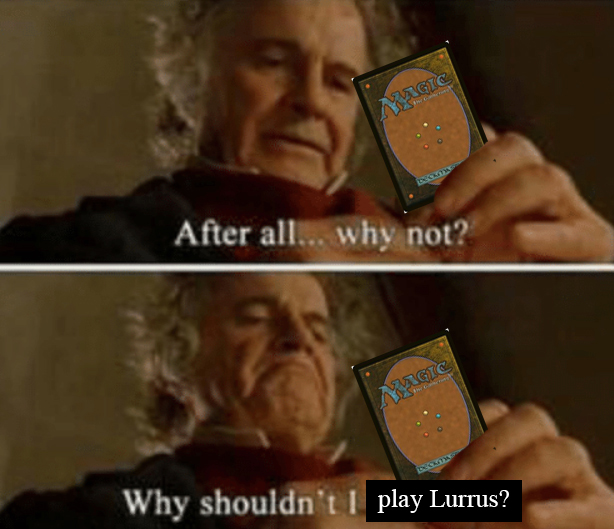
There was one major reason: Lurrus is black, white, or both, while RG Prowess is... well, RG. And another reason: a big draw to splashing green at all was Hooting Mandrills, which is incompatible with the companion's condition.
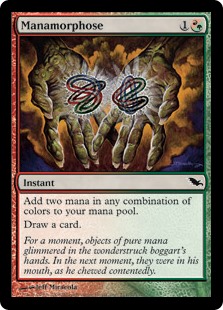 Of course, I was able to rationalize my way out of these pitfalls. It wouldn't be prowess without a full set of Manamorphose, and those can cast Lurrus. In some games, this functionality would mean sandbagging Manamorphose until turn three or four; in others, Lurrus would just be an incidental burst of value when Manamorphose was drawn. I figured that Manamorphose would become a split card: on one end, it merely cycled for free, enabling prowess or Tarmogoyf synergies along the way. And later in the game, Manamorphose would become Lurrus and whatever juicy target existed in the graveyard.
Of course, I was able to rationalize my way out of these pitfalls. It wouldn't be prowess without a full set of Manamorphose, and those can cast Lurrus. In some games, this functionality would mean sandbagging Manamorphose until turn three or four; in others, Lurrus would just be an incidental burst of value when Manamorphose was drawn. I figured that Manamorphose would become a split card: on one end, it merely cycled for free, enabling prowess or Tarmogoyf synergies along the way. And later in the game, Manamorphose would become Lurrus and whatever juicy target existed in the graveyard.
The question then became whether imbuing Manamorphose with this additional split-card power was worth cutting Hooting Mandrills. The Ape could still be run in the sideboard and brought in for every Game 2 and 3, but we'd be starting without it. In my mind, this gave us slightly more of a Game 1 advantage against grindy decks at the expense of our linear matchups, which I understood to already be pretty solid given such an aggressive strategy.
Evil Wins Again
Like the rest of Modern's weak-willed meta sheep, I couldn't resist the companion's allure, and elected to at least try it. Here's where I landed:
RG Lurrus Prowess, Jordan Boisvert
Additional Tweaks
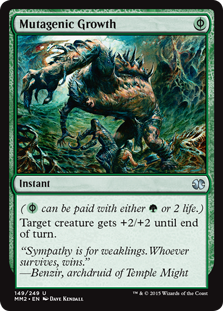 Something had to come in for the two Mandrills, and I went for another old favorite: Mutagenic Growth. Growth has a lot of value in Lightning Bolt matchups, where it acts as Mental Misstep if opponents try to shoot our prowess creature. Heck, it even saves Lurrus from the ubiquitous burn spell! Growth also wins Goyf wars and can be especially nasty with Mandrills when the pair exists in a single construction. Finally, Growth improves another of my additions, Crash Through.
Something had to come in for the two Mandrills, and I went for another old favorite: Mutagenic Growth. Growth has a lot of value in Lightning Bolt matchups, where it acts as Mental Misstep if opponents try to shoot our prowess creature. Heck, it even saves Lurrus from the ubiquitous burn spell! Growth also wins Goyf wars and can be especially nasty with Mandrills when the pair exists in a single construction. Finally, Growth improves another of my additions, Crash Through.
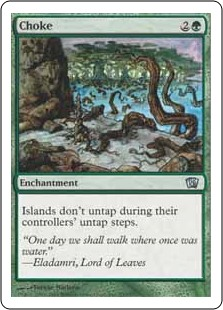 As is always wise to do when taking a refined list and jamming a bunch of your pet cards, I also messed with the sideboard. My first order of business was to add Lurrus and Mandrills; at Kenan's suggestion, gone was Dismember. Kari Zev's Expertise seemed from his article like Kenan's most experimental card, so that also got the axe. But I added one more Choke because I wasn't really trying to not-Choke those Uro decks.
As is always wise to do when taking a refined list and jamming a bunch of your pet cards, I also messed with the sideboard. My first order of business was to add Lurrus and Mandrills; at Kenan's suggestion, gone was Dismember. Kari Zev's Expertise seemed from his article like Kenan's most experimental card, so that also got the axe. But I added one more Choke because I wasn't really trying to not-Choke those Uro decks.
What Lives in the Dream-Den...
...Stays in the Dream-Den. At least, that's how it felt. Even when Lurrus resolved, It rarely won me the game.
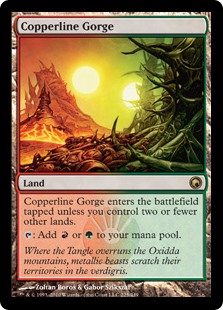 For one, it wasn't a cakewalk to cast. Lurrus would have been great in some games, but I found myself going full Yugi at the top of my deck, praying for Manamorphose to show up (it rarely did). Part of what makes companion so great is the creature's sustained presence in every game; we need to draw Manamorphose before ever casting the 3/2. Even though we'll break even on card advantage thanks to the cantrip, losing out on unrestricted access is a major drawback.
For one, it wasn't a cakewalk to cast. Lurrus would have been great in some games, but I found myself going full Yugi at the top of my deck, praying for Manamorphose to show up (it rarely did). Part of what makes companion so great is the creature's sustained presence in every game; we need to draw Manamorphose before ever casting the 3/2. Even though we'll break even on card advantage thanks to the cantrip, losing out on unrestricted access is a major drawback.
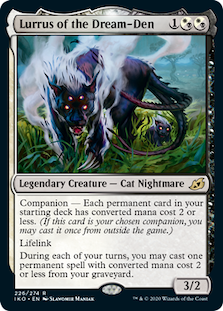 Then there's my impression that Lurrus does not actually improve the grindy matchups I thought it would. A chief reason: those decks are also playing Lurrus---or, if not, Yorion. By building my deck in a way that allowed me to benefit from the companion, I slowed it down somewhat, which gives those decks more opportunities to cast their own. And if there's one thing Prowess does not want to stare down, it's a lifelinker... let alone one that brings back Tarmogoyf. By contrast, Hooting Mandrills laughs in the 3/2's face, critically shrinks opposing Goyfs, and applies immediate pressure rather than vaguely threaten opponents with "I'll draw some more cards, and maybe those will kill you!"
Then there's my impression that Lurrus does not actually improve the grindy matchups I thought it would. A chief reason: those decks are also playing Lurrus---or, if not, Yorion. By building my deck in a way that allowed me to benefit from the companion, I slowed it down somewhat, which gives those decks more opportunities to cast their own. And if there's one thing Prowess does not want to stare down, it's a lifelinker... let alone one that brings back Tarmogoyf. By contrast, Hooting Mandrills laughs in the 3/2's face, critically shrinks opposing Goyfs, and applies immediate pressure rather than vaguely threaten opponents with "I'll draw some more cards, and maybe those will kill you!"
If it's lackluster against grindy removal-spell decks, and clearly bad against faster, linear decks, Lurrus simply doesn't have a role in any matchup for RG Prowess. A difference between the companion here and in a similarly aggro-aligned deck, Burn, is that Burn can just free-roll Lurrus by virtue of already running Inspiring Vantage; we can't. Which brings us to running companions just because.
On Forcing Companions
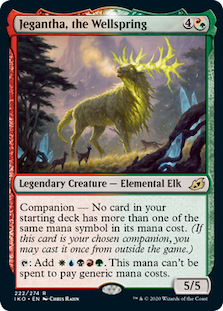 So Lurrus had my head in the clouds. Given how rarely I ended up casting it, and my certainty that Hooting Mandrills is better in Kenan's finely-crafted deck than uh, Mutagenic Growth, I doubt here is the home for the card. Interestingly enough, before adding Lurrus to the shell, I kept track during my games of how often I reached five mana---I'd wanted to see if Jegantha, the Wellspring merited a slot in the sideboard. Unlike Lurrus, Jegantha was always castable color-wise, and what aggro deck doesn't like a free 5/5? After all, we've all had those games where we happen to have way too many lands and would love something to do with them.
So Lurrus had my head in the clouds. Given how rarely I ended up casting it, and my certainty that Hooting Mandrills is better in Kenan's finely-crafted deck than uh, Mutagenic Growth, I doubt here is the home for the card. Interestingly enough, before adding Lurrus to the shell, I kept track during my games of how often I reached five mana---I'd wanted to see if Jegantha, the Wellspring merited a slot in the sideboard. Unlike Lurrus, Jegantha was always castable color-wise, and what aggro deck doesn't like a free 5/5? After all, we've all had those games where we happen to have way too many lands and would love something to do with them.
I continued tracking the numbers after adding Lurrus, and ended up reaching five mana in about 8% of my games. In case that number seems like a lot, I'll add that in many of those games, casting a 5/5 from the sideboard would not have done much for my position. Games that go so long for Prowess are ones in which opponents find ways to stabilize.
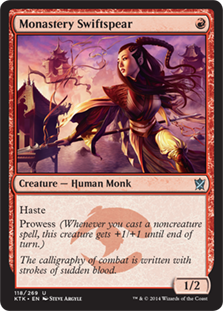 These takeaways bolster David's proposal that the hubbub about companions (in Modern, that is) may be overblown. It's very possible that players are currently over-forcing them, and that some decks stand to gain more value over the course of a tournament from an extra sideboard bullet than from a too-situational "eighth-card" creature. I'm very excited to see theories develop on the benefits of forcing each companion in decks that strategically don't much care for them, but fear we'll have to wait for more data to come in before we get anything truly juicy.
These takeaways bolster David's proposal that the hubbub about companions (in Modern, that is) may be overblown. It's very possible that players are currently over-forcing them, and that some decks stand to gain more value over the course of a tournament from an extra sideboard bullet than from a too-situational "eighth-card" creature. I'm very excited to see theories develop on the benefits of forcing each companion in decks that strategically don't much care for them, but fear we'll have to wait for more data to come in before we get anything truly juicy.
Dream On
As much as I enjoyed my excursion with RG Prowess, Lurrus and otherwise, the deck doesn't offer exactly what I'm after; it lacks stack interaction, for one, and I always feel like a chump casting Soul-Scar Mage. My search for the perfect Modern deck continues. On the bright side, I've got no shortage of time to devote to this noble cause! Here's hoping you readers are at least holed up in quarantine with a Modern deck you love.



